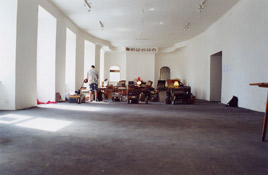NoD Slowly Steps into the Spotlight
With new cafes, galleries, theatres, and cinemas springing up all over Prague, it seems this city is justified to once again call itself a metropolis of culture. There is such a wide range of places to choose from that every evening presents the challenge of just deciding where to go, a far cry from days not so long ago. Yet just imagine a single place that can offer everything culture and the arts demand; a place where people from every nationality can get together and find something they have in common. This is not a utopia, but the Universal Space NoD (No Dimensions), which is certainly on the best way to become a first rate multifunctional art center in the heart of Prague.
 Claiming to be the first independent cultural space for young people, NoD strives to provide a place where people can meet to discuss fresh ideas and experiment creatively. The space officially opened its dusty doors last September, just above the renowned and often controversial Roxy Klub. It was started by a small group of frustrated but ambitious artists, including the ringleader Kristof Kintera, who set out to find a platform for experimental culture. Through the assistance of the Linhart Foundation in Prague, which is headed by Jan Mayer and VladimÌr Lima, the group was able to begin reconstructing the large empty spaces on the second floor. They quickly expanded their groups’ membership, and the center began to take shape. Coming from various artistic backgrounds, such as the fine arts, theatre, film, and new media, the various organizers realized that just another Internet cafe or gallery wasn’t going to be adequate.
Claiming to be the first independent cultural space for young people, NoD strives to provide a place where people can meet to discuss fresh ideas and experiment creatively. The space officially opened its dusty doors last September, just above the renowned and often controversial Roxy Klub. It was started by a small group of frustrated but ambitious artists, including the ringleader Kristof Kintera, who set out to find a platform for experimental culture. Through the assistance of the Linhart Foundation in Prague, which is headed by Jan Mayer and VladimÌr Lima, the group was able to begin reconstructing the large empty spaces on the second floor. They quickly expanded their groups’ membership, and the center began to take shape. Coming from various artistic backgrounds, such as the fine arts, theatre, film, and new media, the various organizers realized that just another Internet cafe or gallery wasn’t going to be adequate.
The theatre space itself (with a large sky dome that lets both day- and moonlight in) encourages young groups and individuals to collaboration by providing workshops, while it also presents the best of alternative contemporary theatre. The media laboratory offers new communication technologies and is in the process of creating an internet magazine that contains information on the cultural life in Prague, including web-casting (broadcasting over the internet). The cinema-screening room connected to the theatre will focus on marginal, alternative and independent genres and will be available to film makers and production groups, while also screening a wide range of alternative films for the public. The gallery is oriented towards both local and international artists that work with various mediums. Thus it offers an alternative to the many commercial galleries that are spattered all over the city.
NoD’s cafe/media lab, its two gallery spaces, and various internet/media workshops have already sparked public attention since its opening, but that is merely a preview of things to come. Upon its planned completion in 2001, the center will also include a bookshop and a performance space. In an attempt to encompass a wide cultural spectrum of facilities, NoD strives to make their center an accessible and attractive place for all who enter its domain. Unlike the majority of spaces in Prague, which present solely Czech art and culture, NoD aims at the international scene.
Although their target audience consists mainly of Czech university art students, the center strives for a global standard and hopes to attract a mixed crowd of visitors, including both foreign and local artists. The planned program of events promises to be exciting: it includes film and poetry festivals, lectures, and various kinds of workshops. At first glance, the center may seem chaotic with its unfinished walls and musty floors, but it is still under construction. If the mess is disregarded, one can find some interesting underground activities almost every night of the week. This new gem of a space may still be in the rough, but it will definitely dazzle Prague’s art scene in the new millennium.




